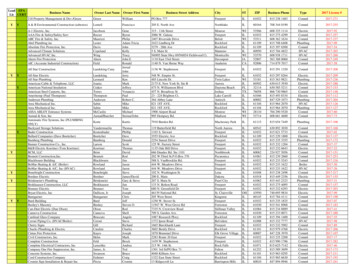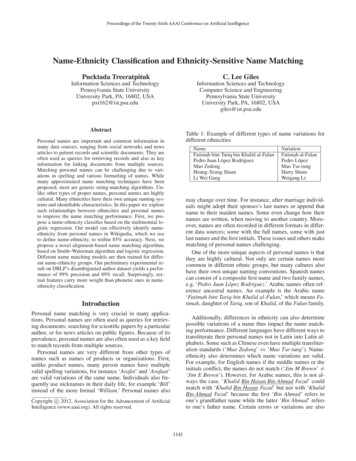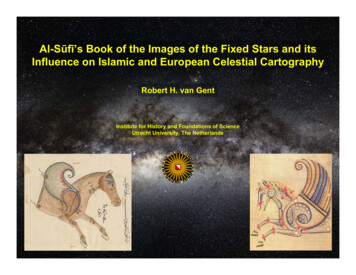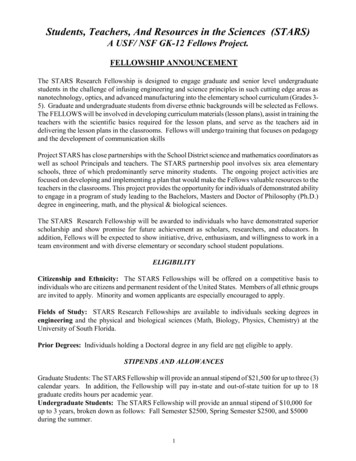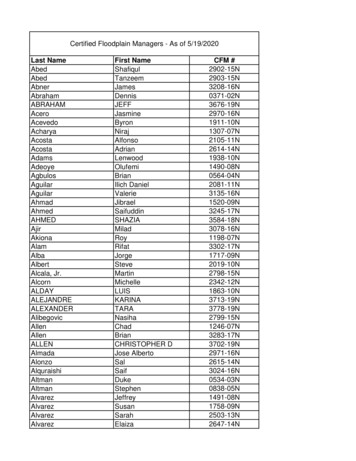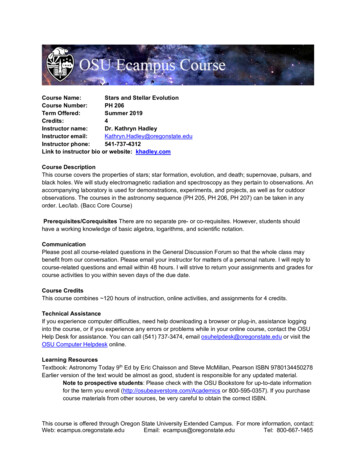
Transcription
Course Name:Stars and Stellar EvolutionCourse Number:PH 206Term Offered:Summer 2019Credits:4Instructor name:Dr. Kathryn HadleyInstructor email:Kathryn.Hadley@oregonstate.eduInstructor phone:541-737-4312Link to instructor bio or website: khadley.comCourse DescriptionThis course covers the properties of stars; star formation, evolution, and death; supernovae, pulsars, andblack holes. We will study electromagnetic radiation and spectroscopy as they pertain to observations. Anaccompanying laboratory is used for demonstrations, experiments, and projects, as well as for outdoorobservations. The courses in the astronomy sequence (PH 205, PH 206, PH 207) can be taken in anyorder. Lec/lab. (Bacc Core Course)Prerequisites/Corequisites There are no separate pre- or co-requisites. However, students shouldhave a working knowledge of basic algebra, logarithms, and scientific notation.CommunicationPlease post all course-related questions in the General Discussion Forum so that the whole class maybenefit from our conversation. Please email your instructor for matters of a personal nature. I will reply tocourse-related questions and email within 48 hours. I will strive to return your assignments and grades forcourse activities to you within seven days of the due date.Course CreditsThis course combines 120 hours of instruction, online activities, and assignments for 4 credits.Technical AssistanceIf you experience computer difficulties, need help downloading a browser or plug-in, assistance logginginto the course, or if you experience any errors or problems while in your online course, contact the OSUHelp Desk for assistance. You can call (541) 737-3474, email osuhelpdesk@oregonstate.edu or visit theOSU Computer Helpdesk online.Learning ResourcesTextbook: Astronomy Today 9th Ed by Eric Chaisson and Steve McMillan, Pearson ISBN 9780134450278Earlier version of the text would be almost as good, student is responsible for any updated material.Note to prospective students: Please check with the OSU Bookstore for up-to-date informationfor the term you enroll (http://osubeaverstore.com/Academics or 800-595-0357). If you purchasecourse materials from other sources, be very careful to obtain the correct ISBN.This course is offered through Oregon State University Extended Campus. For more information, contact:Web: ecampus.oregonstate.eduEmail: ecampus@oregonstate.eduTel: 800-667-1465
CanvasThis course will be delivered via Canvas where you will interact with your classmates and with yourinstructor. Within the course Canvas site, you will access the learning materials, such as the syllabus,class discussions, assignments, projects, and quizzes. To preview how an online course works, visit theEcampus Course Demo. For technical assistance, please visit Ecampus Technical Help.Baccalaureate Core Learning OutcomesThis course fulfills the Baccalaureate Core requirement for the Physical Sciences category. It does this byexploring concepts and theories of the formation and evolution of stars, and applying scientificmethodology to the investigation of these topics. The three Baccalaureate learning outcomes are:1. Recognize and apply concepts and theories of basic physical sciences.2. Apply scientific methodology and demonstrate the ability to draw conclusions based onobservation, analysis, and synthesis.3. Demonstrate connections with other subject areas.Course Specific Learning OutcomesPH 206 aligns with or meets the Baccalaureate learning outcomes in the following ways:1. Recognize and apply concepts and theories of basic physical sciences.In PH 206, you will explore and recognize fundamental concepts of physics as applied to thestudy of stellar evolution. Students develop hypotheses based on their present knowledge,incorporated within the framework of physical laws and apply fundamental principles involved withstar formation and evolution, incorporating new knowledge based on observations of our Sun andstars in general. Students describe the constituent processes in a star, through the gathering ofphysical evidence, from land-based telescopes and space-based observatories such as SOHO.Students communicate with peers using the language of science.Associated activities: Weekly homework assignments are based on the required textbookreadings, tutorials and course web pages. Topical discussions requiring online posts allow you tochoose a topic of interest within a small discussion group, flesh out a short report over the courseof two weeks, and interact with others of your group. You will interact with classmates in othergroups the following week. Discussions include topics such as the biological effects of sunlight,ancient astronomy and black holes.Assessment: Student achievement of this outcome is measured through evaluation of homeworksubmissions, lab reports, discussion posts and exam responses.2. Apply scientific methodology and demonstrate the ability to draw conclusions based onobservation, analysis, and synthesis.You will make firsthand observations of physical phenomena, observe images from telescopes, andengage with virtual experiments via state-of-the-art interactive software. In lab exercises, you willgraph and analyze data of real astrophysical systems as well as virtual simulations, and analyze themotions of stars and planets in the night sky from their firsthand observations.Associated activities: In PH 206, you are required to perform laboratory experiments of four maintypes: (i) Data analysis: for example, for example, graph luminosity vs. temperature for observedstars (ii) Virtual experiments: for example, analyze models of the hydrogen atom using a PhETsimulation to gain understanding of information apparent in stellar spectroscopy, (iii) Citizen-sciencelabs: for example, classifying objects in our galaxy and analyzing images containing proto-stellardisks in our galaxy, (Zooniverse), (iv) Night Sky Journal: catalog weekly observations of the nightsky. If directly viewing the night sky is a problem, virtual observations may be substituted.Assessment: Lab reports are graded for completeness, thoroughness and quality of analysis, andthe student’s ability to draw conclusions regarding the fundamental nature of the system.This course is offered through Oregon State University Extended Campus. For more information, contact:Web: ecampus.oregonstate.eduEmail: ecampus@oregonstate.eduTel: 800-667-1465
3. Demonstrate connections with other subject areas.PH 206 focuses on astronomy as an application of general physics. Students learn basic physicsprinciples such as Newton’s laws and Kepler’s laws, including mathematical applications. Studentslearn the basics of atomic fusion and heat transport.Associated activities: Textbook readings, tutorials and web pages are devoted to the topics offundamental physics and are accompanied by homework activities and a lab exercise. You canchoose to research related topics in the weekly topical discussions.Assessment: Homework exercises and discussions are graded for content, including open-endedquestions regarding fundamental physics.Evaluation of Student PerformanceYour course grade is determined the distribution of points is as follows:Midterm Exam 1: 15%Midterm Exam 2: 15%Final Exam: 30%Homework: 10%Discussion: 10%Lab: 20%At the end of the term, the lower cutoff for an A– will be set no higher than 90%, that for a B– will be setno higher than 80%, that for a C– will be set no higher than 70%, and that for a D– will be set no higherthan 60%. The cutoff may go lower than this.In order to pass the course, you must (1) take all three exams, (2) score a 50% or better on thehomework component, (3) average at least 70% for the lab portion, and (4) obtain the lower cutoff for aD–. Not passing at least 70% for labs will result in a final grade of F. Coursework will not be acceptedafter the beginning of finals week.Course PoliciesDiscussion ParticipationStudents are expected to participate in all graded discussions. While there is great flexibility in onlinecourses, this is not a self-paced course. You will need to participate in our discussions on at least twodifferent days each week, with your first post due no later than Wednesday evening, and your secondpost by Friday and third post due by the end of each week. The first week discussion posts are all due bySunday.Proctored ExamsThis course requires that you take exams under the supervision of an approved proctor. Proctoringguidelines and registration for proctored exams are available online through the Ecampus testing andproctoring website. It is important to submit your proctoring request as early as possible to avoid delays.Makeup ExamsMakeup exams will be given only for missed exams excused in advance by the instructor. Excusedabsences will not be given for airline reservations, routine illness (colds, flu, stomach aches), or othercommon ailments. Excused absences will generally not be given after the absence has occurred, exceptunder very unusual circumstances.This course is offered through Oregon State University Extended Campus. For more information, contact:Web: ecampus.oregonstate.eduEmail: ecampus@oregonstate.eduTel: 800-667-1465
IncompletesIncomplete (I) grades will be granted only in emergency cases (usually only for a death in the family,major illness or injury, or birth of your child), and if the student has turned in 80% of the points possibleand has a passing percentage of at least 70% on the work that has been turned in. If you are having anydifficulty that might prevent you completing the coursework, please don’t wait until the end of the term; letme know right away.Lateness PolicyLate homework and labs will receive a 20% deduction for the first week late, and 20% deduction per weekafterward. Discussion posts will receive a 10% deduction for each day late, and will not be accepted afterthe end of the week (Sunday).Guidelines for a Productive and Effective Online ClassroomStudents are expected to conduct themselves in the course (e.g., on discussion boards, email) incompliance with the university’s regulations regarding civility.Civility is an essential ingredient for academic discourse. All communications for this course should beconducted constructively, civilly, and respectfully. Differences in beliefs, opinions, and approaches are tobe expected. In all you say and do for this course, be professional. Please bring any communications youbelieve to be in violation of this class policy to the attention of your instructor.Active interaction with peers and your instructor is essential to success in this online course, payingparticular attention to the following: Unless indicated otherwise, please complete the readings and view other instructional materialsfor each week before participating in the discussion board. Read your posts carefully before submitting them. Be respectful of others and their opinions, valuing diversity in backgrounds, abilities, andexperiences. Challenging the ideas held by others is an integral aspect of critical thinking and the academicprocess. Please word your responses carefully, and recognize that others are expected tochallenge your ideas. A positive atmosphere of healthy debate is encouraged.Statement Regarding Students with DisabilitiesAccommodations are collaborative efforts between students, faculty, and Disability Access Services(DAS). Students with accommodations approved through DAS are responsible for contacting the facultymember in charge of the course prior to or during the first week of the term to discuss accommodations.Students who believe they are eligible for accommodations but who have not yet obtained approvalthrough DAS should contact DAS immediately at 541-737-4098.Accessibility of Course MaterialsAll materials used in this course are accessible. If you require accommodations please contact DisabilityAccess Services (DAS). Additionally, Canvas, the learning management system through which thiscourse is offered, provides a vendor statement certifying how the platform is accessible to students withdisabilities.Expectations for Student ConductStudent conduct is governed by the university’s policies, as explained in the Student Conduct Code.This course is offered through Oregon State University Extended Campus. For more information, contact:Web: ecampus.oregonstate.eduEmail: ecampus@oregonstate.eduTel: 800-667-1465
Academic IntegrityStudents are expected to comply with all regulations pertaining to academic honesty. For furtherinformation, visit Student Conduct and Community Standards, or contact the office of Student Conductand Mediation at 541-737-3656.OAR 576-015-0020 (2) Academic or Scholarly Dishonesty:a) Academic or Scholarly Dishonesty is defined as an act of deception in which a Student seeks to claimcredit for the work or effort of another person, or uses unauthorized materials or fabricated information inany academic work or research, either through the Student's own efforts or the efforts of another.b) It includes:(i) CHEATING - use or attempted use of unauthorized materials, information or study aids, or anact of deceit by which a Student attempts to misrepresent mastery of academic effort orinformation. This includes but is not limited to unauthorized copying or collaboration on a test orassignment, using prohibited materials and texts, any misuse of an electronic device, or usingany deceptive means to gain academic credit.(ii) FABRICATION - falsification or invention of any information including but not limited tofalsifying research, inventing or exaggerating data, or listing incorrect or fictitious references.(iii) ASSISTING - helping another commit an act of academic dishonesty. This includes but is notlimited to paying or bribing someone to acquire a test or assignment, changing someone's gradesor academic records, taking a test/doing an assignment for someone else by any means,including misuse of an electronic device. It is a violation of Oregon state law to create and offer tosell part or all of an educational assignment to another person (ORS 165.114).(iv) TAMPERING - altering or interfering with evaluation instruments or documents.(v) PLAGIARISM - representing the words or ideas of another person or presenting someoneelse's words, ideas, artistry or data as one's own, or using one's own previously submitted work.Plagiarism includes but is not limited to copying another person's work (including unpublishedmaterial) without appropriate referencing, presenting someone else's opinions and theories asone's own, or working jointly on a project and then submitting it as one's own.c) Academic Dishonesty cases are handled initially by the academic units, following the process outlinedin the University's Academic Dishonesty Report Form, and will also be referred to SCCS for action underthese rules.Conduct in this Online ClassroomStudents are expected to conduct themselves in the course (e.g., on discussion boards, email postings)in compliance with the university's regulations regarding civility.TutoringNetTutor is a leading provider of online tutoring and learner support services fully staffed by experienced,trained and monitored tutors. Students connect to live tutors from any computer that has Internet access.NetTutor provides a virtual whiteboard that allows tutors and students to work on problems in a real timeThis course is offered through Oregon State University Extended Campus. For more information, contact:Web: ecampus.oregonstate.eduEmail: ecampus@oregonstate.eduTel: 800-667-1465
environment. They also have an online writing lab where tutors critique and return essays within 24 to 48hours. Access NetTutor from within your Canvas class by clicking on the NetTutor button in your coursemenu.OSU Student Evaluation of TeachingCourse evaluation results are extremely important and are used to help me improve this course and thelearning experience of future students. Results from the questions are tabulated anonymously and godirectly to instructors and department heads. Student comments on the open-ended questions arecompiled and confidentially forwarded to each instructor, per OSU procedures. The online StudentEvaluation of Teaching form will be available toward the end of each term, and you will be sentinstructions via ONID by the Office of Academic Programs, Assessment, and Accreditation. You will log into “Student Online Services” to respond to the online questionnaire. The results on the form areanonymous and are not tabulated until after grades are posted.This course is offered through Oregon State University Extended Campus. For more information, contact:Web: ecampus.oregonstate.eduEmail: ecampus@oregonstate.eduTel: 800-667-1465
Course ContentAll deadlines are 11:59 pm on the day indicatedWeekTopicReading Assignments1IntroductionCh 1.3,1.6, 2.5, 2.6,2.7, 2.8EM radiationChapter 32SpectroscopyChapter 43The sunChapter 164The starsChapter 175InterstellarmediumChapter 186Star formationChapter 197Stellar evolutionChapter 208Stellar explosionsChapter 219Neutron stars andblack holesChapter 2210ReviewFinalsLearning ActivitiesDiscussionHW 0Hw 1Lab 1begin Lab 8 observationsDiscussionHw 2Lab 2Activity 1DiscussionHw 3Lab 3DiscussionHw 4Lab 4DiscussionHw 5Lab 8 first submissionMidterm 1DiscussionHw 6Lab 5DiscussionHw 7Lab 6Star Evolutionsmall group discussionDiscussionHw 8No labDiscussionHw 9Lab 7Midterm 2DiscussionLab 8 second submissionFinal Exam(cumulative)Due unSunProctoredSchedule dates are tentative and may be subject to change.This course is offered through Oregon State University Extended Campus. For more information, contact:Web: ecampus.oregonstate.eduEmail: ecampus@oregonstate.eduTel: 800-667-1465
This course is offered through Oregon State University Extended Campus. For more information, contact: Web: ecampus.oregonstate.edu Email: ecampus@oregonstate.edu Tel: 800-667-1465 . Course Name: Stars and Stellar Evolution C

